In its new study ‘The Market for Aircraft Carriers and Amphibious Warfare Ships’, Forecast International projects that a total of 98 ships will be produced from 2019 through 2028.
The value of this production is $65.4 billion.
“The market for aircraft carriers and amphibious warfare ships is expanding steadily, outweighing any other in the maritime sector, and is of profound worldwide importance,” said Forecast International senior warships analyst Stuart Slade.
Of the total number of ships forecast for production, eight are aircraft carriers, comprising two each for Britain and the United States, one for India, and three for China. These eight ships represent 8.16 percent of the unit total for this sector but have an aggregate value of $31.4 billion, 48 percent of the sector total.
A recent decline in the proportion of funding devoted to aircraft carriers reflects a marked slowing of the Indian programme. The amphibious warfare component includes amphibious warfare ships and craft, a segment that includes large amphibious transports of varying types down to air-cushion landing craft, say the firm in a press release.
This market overview covers aircraft carriers ranging from large warships carrying a mixed, multipurpose air group exhibiting the highest performance characteristics to amphibious assault ships that primarily carry transport helicopters, with a limited number of VSTOL aircraft tasked with a restricted number of missions.
“The linkage of these two sectors within a single market overview may seem idiosyncratic, but there are solid operational and technical reasons behind doing so,” said Slade.
“Operationally, the distinction between an aircraft carrier and a large amphibious assault ship is indistinct.”
Even the big U.S. Navy CVNs, the largest and most powerful warships in the world (not to mention by far the most expensive), have at times embarked helicopters and Marines to carry out amphibious operations. The amphibious warfare ships have, when the situation demands, served as small aircraft carriers. The technical link is that the design and to a large extent the size of these ships are determined by the demands of the aircraft they carry.
Forecast International is a provider of Market Intelligence and Consulting in the areas of aerospace, defence, power systems and military electronics and specialises in long-range industry forecasts and market assessments.



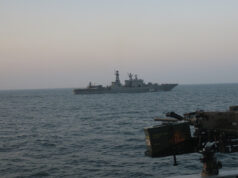
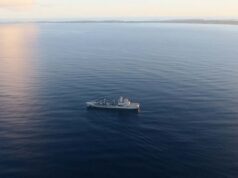
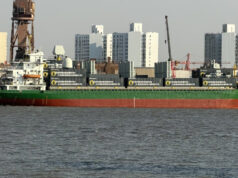
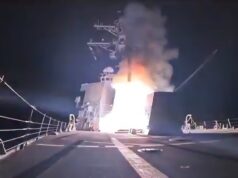
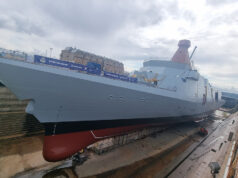


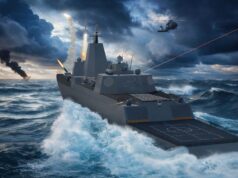
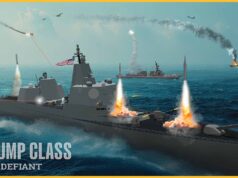
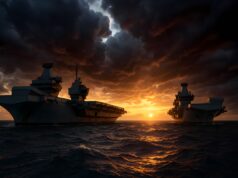

Being such costly assets, can someone point out to me where the third phalanx is sited on QE? Or where she is protected port-side?
Do I assume the third is yet to be fitted…and will we see her enhance CIWS by mounting 2 banks of 10 Martlet (20 missiles) to the Bushmaster? Or do we wait for Iran to produce mass drones to compliment its mass boat swarming capabilities?
As we know, all you may need is enough time/defence till Airborne assets destroy the source, which I hope Britain, the US, and likely Israel are prepared for.
I’m sure we must have Astute positioned with their Tomahawks…
Once Iran develops advanced anti-ship missiles and long range ICBM nuclear capabilities, we better hope that our dependency on oil is far less.
Truly bizarre how we allow a Fundamentalist Theocracy to get away with it, will we ever learn from history?
Will the world eventually become nations of nuclear capabilities waiting for the first one to twitch…
The 3rd CIWS is still to be fitted last time I heard. Mind you, she’s still on her trials so not really an issue anyway. There’s also been some talk of both a 4th CIWS and Sea Ceptor being looked into for fitting on both carriers but that could be just rumours. Martlet is still under trials and not cleared for fitting across the fleet yet (if it ever will be). I doubt it would appear on a carrier, anyway, more useful to fit it to the escorts protecting it. Talk of mass drones, ‘advanced’ anything, ICBM’s or anything else from Iran is just that. Talk. Iran doesn’t have a great record for coming up with the goods. Remember their stealth aircraft that was going to revolutionise their Air Force??
‘By George Allison’ ???
‘Copied and Pasted by George Allison***’
Source:
https://www.globenewswire.com/news-release/2019/08/05/1896664/0/en/Market-for-Aircraft-Carriers-and-Amphibious-Warfare-Ships-Will-Total-65-4B-over-Next-10-Years.html
Why not rewrite it in your own words?
Or at least reference your plagiarism.
Hi Julian,
The article is a press release (hence why it’s actually marked as such on the website), one that Globe Newswire have also republished, they are not the original source either by the way.
Press releases are sent out to multiple outlets for publication. In this case, by Forecast International.
With all due respect, this isn’t a difficult concept.
Regards,
George
UK seem extremely poor in productising our ships for export, the T31 is the first attempt to do this. T26, whilst successful, was not designed at the outset to be an exportable product. Take Damen for example they actually have a product range of ships. The UK yards definitely need to get better at this if they are going to survive without government handouts and tap into some of these potential markets.
The Type 31e would be perfect for Cammell Laird, leave Rosyth for the solid support ships. It would be great to see an English yard building at least some ships or the Royal Navy again.
I think your missing my point, even if the T31 was 500m a pop BAe would rather turn out bespoke warships where they can make more margin and charge the MoD for changes in design. Check the Damen website there’s a products list and you can select a ship from their catalogue, that’s always going to be more cost effective than a bespoke design. So going back the article if UK shipbuilding wants to capitalise on an near 60b possible market we need products to sell and not bespoke warships.
Expat – in a similar vein Fincanteiri also has a good product portfolio,it’s a very competitive market for mid to lower tier Warships.
It’s going to be very interesting to see what the future holds for large deck carriers and amphibs. The USN is currently in the process of reexamining survivability for these classes of vessels in the event of full scale war. It’s my belief that the U.S. will not commit the carrier force to battle in areas covered by area denial envelopes until they are “softened up” by other other assets such as submarines and standoff (air and sea) launched cruise missiles and intermediate range ballistic missiles. Other tactics might include this “back to the past” scenario being examined by the USMC to counter what is becoming a very serious threat in the Pacific.
https://warontherocks.com/2019/07/the-dumbest-concept-ever-just-might-win-wars/
Cheers
When’s HMS Bulwark and Aalbion set to be sold I mean replaced.
Mid 2030’s for Albion and Bulwark.
Looks like the RN is going to join the USN in the Gulf…
https://www.navytimes.com/news/pentagon-congress/2019/08/05/uk-joins-us-in-strait-of-hormuz-naval-security-mission/
It’s always the same. The U.S. and the UK carrying the water (admittedly France does much as well) while other rich nations take the freeloaders route….
Cheers
Time to up gun T45 with sea ceptor and 16 Strike length VLS for TLAM and LRASM, amazing ships just not finished properly but easy enough to fix with a bit of cash and some will from government.
I agree completely Martin but sadly I doubt it will ever happen – FFBNW….. what a curse!
This to me is one of only 2 problems with Type 45. 1) lack of offensive weaponry. Seems crazy to me that any naval task force we send would rely solely on Harpoons from Type 23s and Spearfish torpedoes from what would likely be a single Astute sub.
The second problem is quite simply not enough ships of the class. I know it’s impossible to build any more Type 45s but would it be possible to build two of the Type 26 frigates as air defence variants?
Even the USN’s previously sacrosanct carriers are getting a second look.
https://www.defensenews.com/naval/2019/08/06/with-mounting-questions-about-cost-and-survivability-a-shifting-political-landscape-for-us-aircraft-carriers/
With the evolving idea of distributed warfare, ANY surface combatant should be armed to the teeth with whatever can be crammed aboard it to prepare for the day when the carrier is no longer King. The naval fight will probably carried out by widely deployed and networked destroyer / frigate / submarine type combatants firing advanced missiles with anti submarine and mine sweeping work mostly the domain of drones IMO…
Cheers
The future is going to see more and more use of both autonomous and remotely operated unmanned vehicles working in concert with a ship. With these types of vehicle screening the ship as a scout or as an added layer of defence.
The day of the carrier will never be over, unless an enemy can fully swamp an area with a plethora of weapons that can get through the defensive screens of aircraft, ships and subs.
I agree with your position that carriers will have a place in naval warfare for the foreseeable future Davey. They will merely become another asset to be deployed when the threat to them has been reduced. I can see the USN keeping about 6 CBGs in the future and using them for scenarios other than the primary war fighting platforms with all other ships subordinate to them in the USN hierarchy as they are now.
I also agree with your assessment of the role autonomous systems will play in the future. Aside from the sub hunting and mine sweeping duties, I can perfectly rationalize drone arsenal AAW craft controlled by carrier’s systems serving as their primary defense escorts freeing other major surface combatants to serve as the same for their own “flocks” of autonomous craft. Fascinating to envisage really… I look forward to seeing what evolves here.
Cheers!
Regarding building more Type 45’s. -Politically and Practically impossible yes, Physically impossible no.
Far cheaper just to adapt the T26 for AAW I would have thought.
Well Boris has been spending like a drunk on a Saturday night, but I fear most of that will go to the “usual suspects” i.e. city fees, management consultants, overpaid, virtue signalling public sector non jobs, rather than anything of any use to the public.
One billion on a RN, British built version of the 32000 ton Trieste assault carrier the Italians are building, would be good. Put it in Plymouth for the Royal Marines.